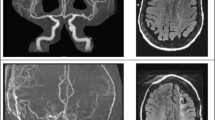Abstract
The aim of this study is to determine the frequency of silent cerebral ischemia (SCI) in a group of patients with β-thalassemia major and correlate them with demographic parameters, blood and spleen status, volume and frequency of transfusions. In this cross-sectional study, 40 β-thalassemic patients over 10 years old who had no neurologic deficit were studied. Brain MRI was performed to detect SCI. Silent cerebral ischemia was classified according to number and size. Silent cerebral ischemia was found in 15 patients (37.5 %). Mean number of SCI was 6.73 ± 10.33 (1–40), and mean size of the brain lesions was 3.07 ± 2.81 mm (1–11 mm). The patients with SCI were significantly older (31.1 ± 6.5 vs. 25 ± 6.8 years, P = 0.009), and most of them were splenectomized (80% vs. 36 %, P = 0.01). Interestingly, 10 out of 15 patients with SCI had platelet count less than 500,000/mm3. Eight of these patients (80 %) were splenectomized. Other variables had no statistically significant association with the presence of SCI. Older age and splenectomized multitransfused β-thalassemic patients even with normal platelet count have a higher incidence of SCI. The effect of splenectomy is more significant in statistical analysis. In splenectomized patients with a high platelet count and even with normal platelet count, aspirin therapy is indicated. Based on the results, it seems that regular blood transfusions are not going to have a significant effect on the number and size of SCI.

Similar content being viewed by others
References
Rund D, Rachmilewitz E (2005) Beta-thalassemia. N Engl J Med 353(11):1135–1146
Rachmilewitz EA, Giardina PJ (2011) How I treat thalassemia. Blood 118(13):3479–3488
Musallam KM, Rivella S, Vichinsky E et al (2013) Non-transfusion-dependent thalassemias. Haematologica 98(6):833–844
Borgna-Pignatti C, Cappellini MD, De Stefano P et al (2005) Survival and complications in thalassemia. Ann N Y Acad Sci 1054:40–47
Ataga K, Cappellini MD, Rachmilewitz EA (2007) Beta-thalassaemia and sickle cell anaemia as paradigms of hypercoagulability. Br J Haematol 139(1):3–13
Taher AT, Otrock ZK, Uthman I et al (2008) Thalassemia and hypercoagulability. Blood Rev 22(5):283–292
Musallam KM, Taher AT, Karimi M et al (2012) Cerebral infarction in β-thalassemia intermedia: breaking the silence. Thromb Res 130(5):695–702
Cappellini MD, Robbiolo L, Bottasso BM et al (2000) Venous thromboembolism and hypercoagulability in splenectomized patients with thalassaemia intermedia. Br J Haematol 111(2):467–473
Karimi M, Bagheri H, Rastgu F et al (2010) Magnetic resonance imaging to determine the incidence of brain ischaemia in patients with beta-thalassaemia intermedia. Thromb Haemost 103(5):989–993
Mikulis DJ, Roberts TP (2007) Neuro MR Protocols. J Magn Reson Imaging 26(4):838–847
Karimi M, Haghpanah S, Bagheri MH et al (2012) Frequency and distribution of asymptomatic brain lesions in patients with β-thalassemia intermedia. Ann Hematol 91(12):1833–1838
Taher AT, Musallam KM, Nasreddine W et al (2010) Asymptomatic brain magnetic resonance imaging abnormalities in splenectomized adults with thalassemia intermedia. J Thromb Haemost 8(1):54–59
Manfrè L, Giarratano E, Maggio A et al (1999) MR imaging of the brain: findings in asymptomatic patients with thalassemia intermedia and sickle cell-thalassemia disease. AJR Am J Roentgenol 173(6):1477–1480
Eldor A, Rachmilewitz EA (2002) The hypercoagulable state in thalassemia. Blood 99(1):36–43
Taher A, Isma'eel H, Mehio G et al (2006) Prevalence of thromboembolic events among 8,860 patients with thalassaemia major and intermedia in the Mediterranean area and Iran. Thromb Haemost 96(4):488–491
Musallam KM, Nasreddine W, Beydoun A et al (2012) Brain positron emission tomography in splenectomized adults with β-thalassemia intermedia: uncovering yet another covert abnormality. Ann Hematol 91(2):235–241
Pazgal I, Inbar E, Cohen M et al (2014) High incidence of thrombotic cerebral lesions in adult patients with beta-thalassemia major. Thromb Res 133(3):S116
Del Principe D, Menichelli A, Di Giulio S et al (1993) Papa PADGEM/GMP-140 expression on platelet membranes from homozygous beta thalassaemic. Br J Haematol 84(1):111–117
Ruf A, Pick M, Deutsch V, Patscheke H et al (1997) In-vivo platelet activation correlates with red cell anionic phospholipid exposure in patients with beta-thalassaemia major. Br J Haematol 98(1):51–56
Eldor A, Krausz Y, Atlan H et al (1989) Platelet survival in patients with beta-thalassemia. Am J Hematol 32(2):94–99
Taher AT, Musallam KM, Karimi M et al (2010) Splenectomy and thrombosis: the case of thalassemia intermedia. J Thromb Haemost 8(10):2152–2158
Cabantchik ZI, Breuer W, Zanninelli G et al (2005) LPI labile plasma iron in iron overload. Best Pract Res Clin Haematol 18(2):277–287
Fibach E, Rachmilewitz EA (2010) The role of antioxidants and iron chelators in the treatment of oxidative stress in thalassemia. Ann N Y Acad Sci 1202:10–16
Acknowledgments
We would like to thank the Shiraz University of Medical Sciences for financial and approval support and MRI technicians of Faghihi Hospital Shiraz, Iran. This paper is relevant to the thesis of F. Toosi with project no. 5092. Also, we thank Shirin Parand for preparation of the manuscript.
Conflict of interest
All authors declare that they have no conflict of interest.
Author information
Authors and Affiliations
Corresponding author
Rights and permissions
About this article
Cite this article
Karimi, M., Toosi, F., Haghpanah, S. et al. The frequency of silent cerebral ischemia in patients with transfusion-dependent β-thalassemia major. Ann Hematol 95, 135–139 (2016). https://doi.org/10.1007/s00277-015-2508-7
Received:
Accepted:
Published:
Issue Date:
DOI: https://doi.org/10.1007/s00277-015-2508-7




